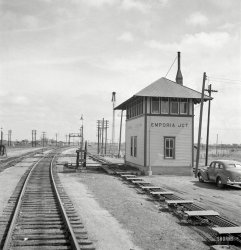
MAY CONTAIN NUTS

Search Shorpy
SHORPY ART

Framed or unframed, desk size to sofa size, printed by us in Arizona and Alabama since 2007. Explore now.
Join and Share
Ad-Free Shorpy
Shorpy is funded by you. Patreon contributors get an ad-free experience.
Learn more.

Recent comments
- Baked goods to go
- Tires
- A Certain Robot
- Still Standing
- All wound up?
- Springy
- This one is inspirational.
- Seasonal Work
- Tomaeto, Tomahto
- Truck ID
- Horton Hears a ...
- From a buggy company came ...
- They call me Mister Horton
- Still Run
- Someone fed Jack some bad info.
- A Beautiful Machine
- It's official.
- Olive Brand Sportswear
- I still have a grudge against Texaco
- No GPS?
- CFG Bank Arena
- Van Lines
- Closed Station?
- John Vachon
- Folding Chairs
- TEXAGO
- Fragi-lay
- Classy
- Passenger seat
- No tipping
Member Photos
The Shorpy
Printporium
Printporium
Search Shorpy
Search results -- 30 results per page
- Refrigerated Freight: 1943
- ...
DaveB
Still there; now part of BNSF Argentine Yard is still in Kansas City, Kansas. Today it is part of the Burlington ... of the smokestacks visible between the oil tanks and the railroad yard seem to have survived. The large warehouse on the east side of ... Posted by Dave - 03/27/2013 - 7:09pm -
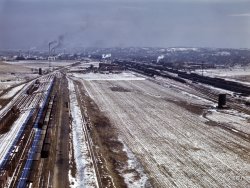
- The Flavor Lasts: 1940
- ... Just what every kid needs A Wabash boxcar in the back yard!
Looks like a brand new Ford sitting there in the alley. Don't ... landlord?
HO Scale What an excellent subject for a railroad diorama.
Dept. of Sanitation I'm impressed (or depressed?) by ... Posted by Dave - 05/17/2011 - 4:56pm -
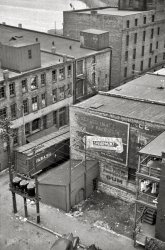
- Chicago & Alton: 1904
- Circa 1904. "Chicago & Alton Railroad shops at Bloomington, Illinois." At left rear, the Anheuser-Busch beer ... then. Interesting.
[The chalk markings are from the yard crews, noting such things as routing, special content advisories, repairs ... Posted by Dave - 01/10/2014 - 11:45am -
![Chicago & Alton: 1904 Circa 1904. "Chicago & Alton Railroad shops at Bloomington, Illinois." At left rear, the Anheuser-Busch beer boxcar. 8x10 inch glass negative. View full size.
GraffitiI like the graffiti on the side of the train. People were doing that even back then. Interesting.
[The chalk markings are from the yard crews, noting such things as routing, special content advisories, repairs required, etc. Often seen on rail yard photos here on Shorpy. -tterrace]
C&A Blues"I said, let me tell you, peoples
What the C&A will do for you
Well, now she will take yo' little woman
Then will holler back at you..."
From The C&A Blues, by Peetie Wheatland, circa 1930
No DumpingThe old shops are gone, you can still see the foundations on Google Earth at
https://goo.gl/maps/BQFNq
It looks like there may have been a turntable just to the south of the main building.
Also, the shops can be seen in an old postcard on the Wikipedia page for the Alton Railroad at
http://en.wikipedia.org/wiki/Alton_Railroad
There is no good street view of the site, the road stubs leading into the site all have the same sign: No Dumping.
(The Gallery, DPC, Railroads)](https://www.shorpy.com/files/images/SHORPY_4a20233a.thumbnail.jpg)
- Jacked: 1942
- ... up a car on the repair tracks at an Illinois Central Railroad yard." Someone get the spare out of the trunk? Medium-format negative by Jack ... Posted by Dave - 08/21/2013 - 2:19pm -
![Jacked: 1942 November 1942. "Chicago, Illinois. Jacking up a car on the repair tracks at an Illinois Central Railroad yard." Someone get the spare out of the trunk? Medium-format negative by Jack Delano, Office of War Information. View full size.
RIP: 1942Delano caught it on one of the RIP tracks. Repair In Place.
Treble MemoryI believe both wheels shared a common axe. So to make a change he needs another jack. Quiz time: why were the outer rims tapered?
[That axe never stops sharpening. - Dave]
Doh!When they told him to go get a Duff he thought they meant Beer.
Not just trucking aroundThere probably is another jack out of view to the left. He'll be removing the whole truck (both axes...er...axles and all 4 wheels). If he was just removing one pair of whhels he'd have to support the truck somehow instead of the frame of the car.
Don't Damage the FinishWe first saw a track jack and Texas toothpick back here. I don't quite understand the padding that seems to be sitting on the business end of the jack.
Tapered wheelsTapered wheels keep the wheels centered on the rails and allow for the different distances each wheel travels when going around curves since they have a solid connection via the axle to the opposite wheel. In an ideal world the flanges should never touch the rails in reality they do however.
Wheel taperWheel taper is 2 degrees 50 minutes. The taper is designed to keep the flanges off the rail heads and to eliminate hunting. The wheels are pressed onto the axles. This particular car has 33 inch wheels and plain bearings. It would be another 20 years before roller bearings were in widespread use on freight cars.
That guy has some "get up and go"Now that's what I call a faith-based initiative!
That JackThat jack is very similar to the ones my father had stored in his garage. He used a couple to jack up the front and back porches on his house (for long term stability). He called them "house" jacks, and I'm sure they are still doing their jobs 60 years after installation!
Trucks and solid axles. With the solid friction bearing axles as in this pictured truck. The truck needs to be disassembled to replace a wheel set (2 wheels and axle). The paper between the jack and steel body is to reduce slipping of the steel on steel surface.
(The Gallery, Jack Delano, Railroads)](https://www.shorpy.com/files/images/SHORPY_8d23268a.thumbnail.jpg)
- Jackson Sevens: 1939
- ... and Mill streets you can use Google Maps to see there are railroad tracks nearby to the east. In Shorpy's photo you can see an address ... so look exactly alike . The house has a sign in the yard that says "306 N. State." The station is at 300 North State. - Dave]
... Posted by Dave - 04/10/2019 - 1:10am -
![Jackson Sevens: 1939 November 1939. "Gas station in front of old colonial house (306 North State Street). Jackson, Mississippi Delta." The 777 Service Station, pumping Sinclair "H-C" gasoline. Acetate negative by Marion Post Wolcott. View full size.
300 North StatePhone 2-0777
Case of the spying Sinclair servicemanThis one gave me a little chuckle. Ms. Wolcott probably asked the owner if she could take a photo of his station. Distrustfully, he may have said: "Well, alright. But don't put me in it, I will go inside until you are finished." If he were around today, he might be surprised to see himself through the station window, peering out at the photographic proceedings -- again -- distrustfully.
Spite stationThere must be a good story behind this one involving a zoning dispute. This looks to be almost as egregious as the Crocker spite fence!
Lost JacksonSadly, this charming scene from 1939 has been replaced by a sea of faceless warehouses and parking lots.
EvolutionThe first iteration of the Sinclair dinosaur was apparently an "old colonial house."
Changing TimesI think this is more a case of a property owner making the best use of their property as the area around them changes. My scenario is:
Long before 1939 an owner built a large, columned mansion in the country on a large lot or acreage on small hilltop (to catch any breeze).
The neighborhood changes and by 1939 a Sinclair gas station is a profitable option for the corner property upon which the house now sits. I believe this is the station in 1979.
In this photo the house is gone and the small hilltop is leveled. Using the location in this photo of the NE corner of Hamilton and Mill streets you can use Google Maps to see there are railroad tracks nearby to the east. In Shorpy's photo you can see an address 306 for the house. 306 Mill Street puts the house at the correct corner in the 1979 photo. And if you switch to satellite view you can see that immediate area is pretty much industrial now. I suspect the 1939 owners saw it coming.
[As noted in our photo caption, the address of the house is 306 North State Street -- not Mill Street. The service station, whose address was given in the first comment below, was at the corner of North State and Yazoo. - Dave]
Now either the Eudora Welty Public LibraryOr the parking lot for said library.
At least the library is historically significant, from the time of the Civil Rights movement, where a large sit in originated at the library. The photo in question was probably taken from across the street, in front of the (now gone) 1st Presbyterian Church of Jackson, which closed in 1951, at least per the two historic street markers there.
Long goneso much for the luck of sevens - both the gas station and the home are long gone, replaced by the Eudora Welty Library.
No Survivors to This DisputeNeither the filling station nor the fine old home survive. There is the Eudora Welty Library and a parking lot. Not able to google up the explanation how zoning, bad taste, or a family dispute let this combination happen.
What Google does tell me is that, in 1947, a Sears was built on this site, and that when the Sears closed in the late 80s, it became the Eudora Welty Library.
77Mill Street or North State Street, the cutoff sign mid-left foreground makes me wish it were Sunset Strip.
Dual 777 StationsThe address on N. State must be the Sippiana Succotash station with picture here; http://sippianasuccotash.blogspot.com/2012/09/777-service-station-and-mu...
Whereas the link to the 1979 picture provided earlier is definitely the station in the image today. At the corner of Hamilton and Mill St. like the picture says. The Church just east of the station in the 1979 image is still there if you fly in on Google earth. https://misspreservation.com/2017/07/14/friday-is-a-gas-sinclair-station...
[You are perhaps confused by the fact that most Sinclair stations of the era used the same design, and so look exactly alike. The house has a sign in the yard that says "306 N. State." The station is at 300 North State. - Dave]
The Library in Questionused to be a Sears store. The large, gray disused building on the west side of State Street used to be the library. Furthermore, Jackson is nowhere near the Mississippi Delta.
(The Gallery, Gas Stations, M.P. Wolcott)](https://www.shorpy.com/files/images/SHORPY-8c10739a.thumbnail.jpg)
- Public hanging
- ... “Pat” Casey, who, like Femenella, was employed as a railroad section hand in the city of Granite. The murder resulted from a ... seventy-five people were admitted to the jail yard to witness the hanging, and a “large crowd” mingled outside the jail ... Posted by William - 09/20/2011 - 8:51pm -
![Public hanging I found the negative in a cigar box that was tossed into a dumpster in Portland, Oregon. I have no idea of the history. View full size.
Maybe around Denver?I googled the name, came up with very little except the name showing up twice in the undigized list of the Denver Public Library. There is a town in Colorado called Buena Vista.
Newspaper article Chaffee County Times, Colorado
In 1888, the first legal hanging was held in this area behind the courthouse. This was the hanging of Nicolo Feminella, who was convicted of the murder of a fellow miner.
Some historyHere is a link to a story that mentions this event in passing: http://www.chaffeecountytimes.com/main.asp?SectionID=7&SubSectionID=7&Ar...
"In 1888, the first legal hanging was held in this area behind the courthouse. This was the hanging of Nicolo Feminella, who was convicted of the murder of a fellow miner. A lot of history has evolved in this area and in the old McGinnis Gym."
Building on the old gym news story...The Chaffee County Courthouse and Jail Buildings are now a museum.
http://www.buenavistaheritage.org/Page.aspx?PageID=2355
at the bottom of the page:
The large room at the top of the stairs was once the heart of this venerable old building. This courtroom was the scene of many exciting cases. The fate of Nicolo Ferminello, an Italian accused of stabbing a man to death, was decided here. He was sentenced to die for his crime and his is Chaffee County's only "legal" hanging. He was hanged at the back of the jail complex. The room, which is now available for rental, has the original judge's bench and chair.
notice the use of scare quotes around legal hanging...
Big!Seems like an awfully big and heavy structure for a single hanging. Surely the forces sufficient to snap his neck would not have been anywhere near sufficient to need all those 2x8s, braces, and so on. Of course, lumber was cheap....
GallowsIt is a counter weight gallows. The condemned was led to the rope at ground level. A very heavy weight was released jerking him into the air.
In this picture the man is being lowered by raising the weight out of the picture to the left. Some spectators are watching this. On the left side of the picture you can see the tought rope leading down to the weight.
[Little known fact: only educated ropes were used for hangings.]
Cigar box?You found this photo in a cigar box in a dumpster??? That's odd...that photo might be worth something. I would keep it and frame it, it's a piece of history.
Another version of the history of this hanging...Source: coloradodefenders.us
This was the 24th execution in Colorado:
NICOLAI FEMENELLA (a.k.a. Mike George). August 23, 1888. Buena Vista (Chaffee County). W-W. Hanging/Broken neck. An Italian immigrant, Femenella was convicted of murdering Irishman William “Pat” Casey, who, like Femenella, was employed as a railroad section hand in the city of Granite. The murder resulted from a quarrel between several Irish and Italian immigrants about the men’s different ethnic heritages. After his conviction, Femenella began to claim that he killed in self-defense, a plea that may have saved him from the gallows had he originally used it at trial.387 Governor Alva Adams deferred the execution on three occasions. “According to prevalent opinion here Femenella has received more consideration than would be accorded to the majority of lifelong citizens in this community.”388 Approximately seventy-five people were admitted to the jail yard to witness the hanging, and a “large crowd” mingled outside the jail fence. He was hanged with rope left over from that ordered from a St. Louis company to hang Andrew Green (q.v.).389
(ShorpyBlog, Member Gallery)](https://www.shorpy.com/files/images/Hangin.thumbnail.jpg)
- Low Rider: 1942
- ... roundhouse at the Chicago & North Western RR's Proviso Yard." 4x5 Kodachrome transparency by Jack Delano for the Office of War ... the pits are still 1940's era. We now service Long Island Railroad diesel engines. In the photo subject's day, the majority of the oil ... Posted by Dave - 08/30/2012 - 4:45pm -
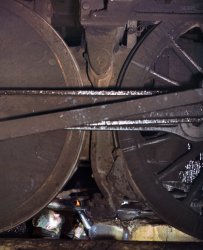
- Swiping Coal: 1917
- ... GE 44 tonner. As a young boy, I lived very close to the railroad tracks. My mum would send my brothers and me off with a metal bucket ... and not far from what is now a Norfolk Southern rail yard.
Whenever there was a line of coal cars parked in the yard the word ... Posted by Dave - 09/30/2020 - 2:36pm -
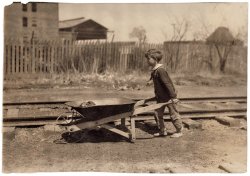
- Colossus: 1904
- ... half of them.
Four Independent Wheels
The Railroad Gazette, Nov 18, 1904.
General News Section
The ... on the Detroit river, was recently launched at the Ecorse yard. The Detroit measures 308 ft. on deck, has 64 ft. beam and is 19½ ... Posted by Dave - 05/28/2011 - 2:58am -
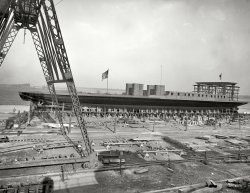
- Midnight Special: 1943
- ... train about to leave the Atchison, Topeka & Santa Fe Railroad yard for the West Coast." Medium-format nitrate negative by Jack Delano for the ... Posted by Dave - 01/28/2013 - 12:23am -
![Midnight Special: 1943 March 1943. Argentine, Kansas. "Freight train about to leave the Atchison, Topeka & Santa Fe Railroad yard for the West Coast." Medium-format nitrate negative by Jack Delano for the Office of War Information. View full size.
AT&SF # 31672-8-2 "Mikado" type. Lost in a flood in 1952 and now sunk in the Kaw River in Topeka, KS.
What a Flood!The ATSF Argentine yard is in Kansas City.
The Santa Fe placed several old engines on its bridge over the Kansas River (sometimes called the "Kaw") in Topeka to try to keep the bridge from being washed away during the 1951 -- it was 1951, not 1952 -- flood. It didn't work. The engines weren't salvaged after the flood and reportedly parts of them could be seen in the sandbars at low water levels for years.
The ATSF bridge wasn't on the main line, but the Rock Island also lost its Topeka bridge during the flood, which was on its main line to the southwest. The city also lost two of four street bridges over the river.
The water reached the street in front of my house, and we had to pump water out of the basement, but the house was up the hill a bit and wasn't otherwise affected. It was the biggest flood ever in Topeka.
Steam at nightThere's an interesting technicality in this shot. The time exposure to ambient light means that there are light trails from the loco lights and a lot of motion blur in the steam, the train alongside and so on. However, the long burn time of the flash bulbs meant that there's motion blur in the flash part of the exposure, too.
[This isn't a flash shot. The illumination is from lights mounted atop tall standards in the yard. - tterrace]
1 month oldMarch 1943: I would have been 1 month old. These Jack Delano railroad shots are fantastic moments in time. I can hear the hissing of steam, the smell of the exhaust and hot grease; the plaintive call of the steam whistle as I lay in my bed on a cold winter night. As a boy who spent his childhood summer days sitting by the tracks, these photos stir up a whole bunch of poignantly fond memories. I waved at the engineer who always waved back. As the caboose brought up the end of the train, they are now extinct, passed, the conductor would acknowledge my wave as he sat up in the cupola. If I were lucky, there was another engine coupled at the rear behind the caboose and another engineer to salute. I cherish the fact that I was born early enough to have witnessed steam locomotives as part of the passing scene. However, I regret the fact that I was born way too late to have been a steam locomotive engineer. Yes, I am truly an old geezer!
(The Gallery, Jack Delano, Railroads)](https://www.shorpy.com/files/images/SHORPY_8d26518a.thumbnail.jpg)
- Clovis Man: 1943
- ... his locomotive out of the Atchison, Topeka and Santa Fe Railroad yard." Medium-format negative by Jack Delano, Office of War Information. View ... sad but fascinating thing to trace the evolution of railroad names as they merged themselves out of existence over the last several ... Posted by Dave - 06/17/2009 - 8:36pm -
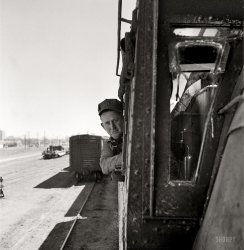
- Diesel Freight: 1943
- ... entering town along the Atchison, Topeka & Santa Fe Railroad between Winslow and Seligman." Photo by Jack Delano for the Office of ... of those old girls rotting away in the Union Pacific
yard In Cheyenne, WO.
Very Similar To 103 Very similar locomotive to ... Posted by Dave - 09/23/2013 - 9:53am -
![Diesel Freight: 1943 March 1943. "Flagstaff, Arizona. Diesel locomotive entering town along the Atchison, Topeka & Santa Fe Railroad between Winslow and Seligman." Photo by Jack Delano for the Office of War Information. View full size.
Color scheme You are correct, the blue and yellow was for freight and the silver and red was passenger. That isn't to say it was a hard fast rule, but there was different gearing on passenger locomotives for a higher speed.
SighThere are a bunch of those old girls rotting away in the Union Pacific
yard In Cheyenne, WO.
Very Similar To 103Very similar locomotive to this Shorpy post from years past.
Perfect SolutionDiesels don't need water, which is why early diesel power flourished on ATSF, particularly in the southwest. Locomotives like 2-8-2 3137 in background wouldn't last much longer in the arid divisions across Arizona, but she did have ten more years in her on the eastern divisions, not going to scrap until 1953.
Color SchemeConsidering the Santa Fe emblem and the engine number, I suspect Vonderbees has the correct paint colors for this locomotive. As a child growing up in Amarillo in the 50s-mid 60s I recall most of the Santa Fe engines I saw had the red and yellow paint scheme as shown in this previous Shorpy post rather than the blue and yellow scheme. Currently living less than two blocks from a BNSF line, I see lots of the red/yellow scheme though the red is more orange red than I remember as a child.
Rationing exemptionsEMD was the only manufacturer permitted to build diesel-electric locomotives during the war, even though diesels were what most railroads wanted. Having never built a steam locomotive, they were exempt from the War Production Board's requirement to use only old and well-proven technology. This special exemption gave EMD a huge advantage over Alco and Baldwin after the war. In the end, General Electric was and is the only company able to compete.
Much of their output was allocated to the ATSF, due to the water supply problems already mentioned.
[Electro-Motive was a division of General Motors, not General Electric. - Dave]
I meant that General Electric was and is the only locomotive manufacturer able to compete with Electro-Motive, until recently a division of General Motors.
Re: Color SchemeI always figured the blue and yellow color scheme was for freight trains and the red and yellow was for passenger trains. Does anybody know?
Nice styleThe front of this is how all the passenger diesels looked when I was a kid and I think it's still by far the most attractive design. I don't know why they departed from it.
Lectrogeek68 is basically correctin that General Electric was EMD's only true competitor until their roles reversed in the 1990s, and GE displaced EMD as the dominant locomotive manufacturer in North America. In 2010 Caterpillar purchased what was left of EMD from a consortium of private equity firms who purchased the division from GM in 2005, and is seeking to reverse that.
I honed many a cylinder liner and rough cut more piston castings than I care to remember at EMD's McCook plant during the summers of my undergraduate college years.
At the end of their careersHere is a photograph of some sister locomotives stripped of various parts including their road trucks awaiting scrap.
(The Gallery, Jack Delano, Railroads)](https://www.shorpy.com/files/images/SHORPY_8d27318a.thumbnail.jpg)
- Boston Harbor: 1906
- ... Electric Illuminating Company of Boston, Station # 3. The railroad cars on tracks in the foreground are quite likely about to the cross ... down from there to the water was (and still is) the Navy Yard, though I don't see the USS Constitution. Browsing some old Boston Maps ... Posted by Dave - 08/15/2012 - 4:36pm -
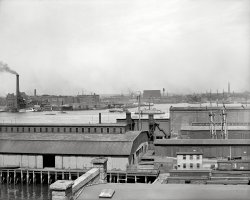
- Iron Ore on Erie: 1900
- ... page in this picture) to service different parts of the yard. I think there are elevators/bucket lifts on the input side that puts the ... it up, and then move either over the large piles, or over railroad cars to dump the load.
Rebuilds... The hopper cars on the far ... Posted by Dave - 06/25/2016 - 10:09am -
![Iron Ore on Erie: 1900 Circa 1900. "Lake Shore & Michigan Southern Railway ore docks, Ashtabula, Ohio." 8x10 inch glass negative, Detroit Publishing Company. View full size.
Clean, but ...Am struck by how clean this busy site seems to be. Of course, those massive piles of iron ore are a rust-red color and that tint might prevail all across the scene. A really fine steel industry shot. Glad you put it up.
Cranes?How did those Crane like thingies in the background work?
When You're Out of Schlitz ...That little Schlitz private owner refrigerator car was the prototype for one of the most popular Walther kits for kids like me, whose parents could only afford a Marx 027 set. At 36ft long in real life, it scaled down small enough to go around the 027 curves, and still let an impecunious kid build a "proper" piece of model rolling stock. I still have mine.
I'm often reminded of painters and paintings on this site. Today it's Charles Sheeler, particularly the smaller sized version.
[Tiny Charles Sheeler is one of my favorites, too. - Dave]
"Cranes"I think those are actually movable sets of elevators/conveyor belts. They transfer the material (coal) from one side and then dump it into the piles you see. They move side-to-side (into and out of the page in this picture) to service different parts of the yard. I think there are elevators/bucket lifts on the input side that puts the material on the belts which climb then the stuff falls off the free end.
Still thereThe docks are still there, with ore trains and big piles of ore. Only the equipment has disappeared. I imagine that a modern loader can move a third of a carload in one scoop.
D for dedicatedThe Lake Shore & Michigan Southern gondolas have the letter D prefacing the car number. This told car checkers the car was in dedicated service so not to be taken off its current route. In this case mine to pier to steel mill over and over again.
The ore bridges were a step up from the whirley cranes but soon have competition from massive Hullet unloaders with their grasshopper-like dipping legs.
The ground looks clean since this was an area where only the most foolish non-railroader would tread and drop trash. There is little in this photo that a safety inspector would praise. Those crib retaining walls being a first concern.
Short-lived lighthouseThe lighthouse at the left side of the picture dates this to between 1897 and 1904, the latter date when these facilities were doubled in size and a whole new terminal was built for the Pennsy. It served as the rear light of pair to guide ships into the harbor. With the expansion a new tower was built in the new section, and that was all she wrote for this one.
More "Cranes"Those structures do not have conveyor belts - if you look closely, you can see a few of the buckets at various distances from the ship. There are small 'trolleys' which move along the bridge-like structures, one on each. Each trolley caries a bucket (probably clamshell) which can reach into the ship's hold, remove some ore (or coal, but I suspect ore), raise it up, and then move either over the large piles, or over railroad cars to dump the load.
Rebuilds...The hopper cars on the far right look to be rebuilds from earlier composite hoppers. Composite types had metal frames, and wooden sides with metal bracing. These cars, however, look to be of an all metal construction. While not overly common in 1900, all metal construction hoppers were starting to come into use. The cars had a longer life span than the wooden composite types, and actually ended up being cheaper to operate in the grand scheme of things.
(The Gallery, Boats & Bridges, DPC, Mining, Railroads)](https://www.shorpy.com/files/images/SHORPY-4a08380a1.thumbnail.jpg)
- Over and Under: 1936
- ... that control the path that a train takes through the rail yard.
The only computer in this 1936 image is the brain of the guy in the ... arms akimbo, trying to decide if he should call the railroad police on the strange dude taking pictures of railroad infrastructure. ... Posted by Dave - 06/25/2021 - 6:30pm -
![Over and Under: 1936 April 1936. "Housing conditions in crowded parts of Milwaukee. Housing under the Wisconsin Avenue viaduct." Photo by Carl Mydans for the Resettlement Administration. View full size.
InterlockingThe maze of trackwork is controlled as an interlocking from the signal tower. The elevated pipes are the rods controlling the switches that determine the direction of travel and the signals that control train movement through the interlocking. The signalman moves the switches by large levers in the tower. It's called an "armstrong" system because of that. The signals are semaphore signals, probably of the upper quadrant type. There is another of the interlocking system signals behind the man in the image. The vertical signal blade is likely giving a train engineer permission to move through the left hand track of the two curving off to the right. Upper quadrant signals were deemed safer than lower quadrant ones as the blade would drop to the horizontal "stop" position in the event of a signal malfunction. Interlockings like this are now controlled from an operations center miles away from the interlocking. A few interlockings and semaphore signals like these may still exist somewhere in the US.
I spyA guy between the tracks carrying something white. A signal device which I hope commenters will explain. A streetcar zipping across a rail bridge. A crisp array of laundry on the line. An intriguing series of diagonal shadows falling from that pipe-y business running close to the ground between the houses and the tracks. And -- up up up – three pigeons, one with its wings caught forever in mid-flap.
"Pipe-y Business"The "pipe-y business" mentioned in jd taylor's comment are push rods that are connected to large levers in the switch tower. The other end of the pipes are mechanically connected to the various switches that control the path that a train takes through the rail yard.
The only computer in this 1936 image is the brain of the guy in the switch tower to control where the train goes.
The pipe-y business and the signal deviceThose are the connections between the track switches and the "Armstrong" levers in the control tower. To move a train from one line to another the tower man pulls the correct Armstrong levers and the rods connecting the lever to the track cause the switch to move. Later, these movements are accomplished electrically with much less effort, but are still controlled from the tower.
The signal device is called a train order board and tells the oncoming trains to proceed, slow or stop. Simply put, straight up is proceed. Diagonal board is a slow order, and horizontal means STOP! The two order boards control two tracks.
The ValleyI worked on the west side of Milwaukee briefly in the '80s, the area called The Valley. This Shorp looks reminiscent of my time there (minus the homes under the bridge).
Drying clothesThe lady of the house would need to get the laundry in before the train comes by, otherwise the laundry won’t be very clean.
Mr. Mydans is being watched... by the vigilant signalman in the tower, who is standing, arms akimbo, trying to decide if he should call the railroad police on the strange dude taking pictures of railroad infrastructure. Amazing how much detail those large format cameras picked up.
[Medium format (Speed Graphic 3¼x4¼). - Dave]
Compared to the typical imager in most consumer-level gear, any format larger than 35 mm is 'large' today, and digital backs for medium format and larger cameras are priced well out of reach for mere mortals...
Lots going on here That guy on the tracks isn't holding any signal device. The guy in the signal tower is about to yell at him through the open window to get off the tracks. At any rate, he's almost to his destination, the F. Knop Tavern, just out of view on the right.
The "pipey-business"controls the switches in the railyard from that little square 4 window building on the left, all hand powered.
(The Gallery, Boats & Bridges, Carl Mydans, Milwaukee, Railroads)](https://www.shorpy.com/files/images/SHORPY-8b28633a.thumbnail.jpg)
- Eggerss-O'Flyng: 1938
- November 1938. "Railroad and coal yard, Omaha, Nebraska." Medium format acetate negative by John Vachon for the ... guess it is a Chicago, St Paul, Minneapolis & Omaha RR yard, because the CStPM&O was a subsidiary of the Chicago & ... Posted by Dave - 08/08/2020 - 10:15am -
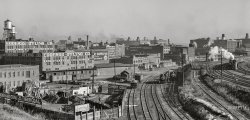
- Steel Wheels: 1942
- ... In the locomotive repair shops at an Illinois Central Railroad yard." Photo by Jack Delano, Office of War Information. View full size.
... Posted by Dave - 10/28/2013 - 11:31am -
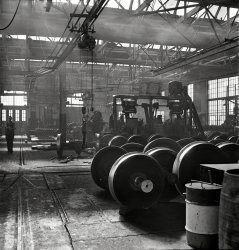
- Be It Ever So Humble: 1938
- ... our parents would have let us construct it in the back yard.
Jug Band Music Seeing the washboard in this picture makes me ... was a simple shack, or series of shacks, mounted on railroad flat cars, to provide accomodations for the workers in the camps. The ... Posted by Dave - 02/09/2012 - 12:24pm -
![Be It Ever So Humble: 1938 November 1938. "Shack of day laborer who works in sugarcane fields near New Iberia. He comes from a parish in northern Louisiana." 35mm nitrate negative by Russell Lee for the Farm Security Administration. View full size.
Insensitive commentA set-up for a Laurel & Hardy gag if I ever saw one.
Flanged wheelsare under the hut. Fascinating.
Kids' dreamWhen I was 10 years old, this would have been just the kind of clubhouse / tree house that my friends and I would have loved to have built from scrap lumber, if only our parents would have let us construct it in the back yard.
Jug Band MusicSeeing the washboard in this picture makes me wonder if there isn't a guitar just inside the door ready for an impromptu tune.
[More likely some dirty laundry.]
On the fenceThe laundry's dryin' on the fence, Dave.
[Comment Czar - not Dave, btw - acknowledges your observation, but speculates our fellow may have separated out his whites and still needs to do his union suit.]
Early WinnebagoPrototype motor home?
About those flanged wheelsI was recently reading an article on the sawmill towns of western Louisiana. A large part of the article was devoted to the types of company housing used in the towns.
One type of housing used in the temporary logging camps [called "front camps"] was a simple shack, or series of shacks, mounted on railroad flat cars, to provide accomodations for the workers in the camps. The shacks would simply be wheeled into place on the company rail line and then withdrawn to the next location once all the timber had been cut out.
Looks like this might have been one of those "mobile homes" left over from the sawmill days, since by 1938 most of the western Louisiana timber lands were a wasteland of cut-over stumps.
(The Gallery, Agriculture, Russell Lee)](https://www.shorpy.com/files/images/SHORPY_8a24815a.thumbnail.jpg)
- Wholesale Minneapolis: 1939
- September 1939. "Railroad yards, wholesale district, Minneapolis, Minnesota." A nice view of the ... View full size.
No more rails. This rail yard was between North First and Second Streets, running from Fourth Avenue ... residential district. All converted to condos and the rail yard filled in with new condos. An interesting side note, a residential ... Posted by Dave - 03/23/2013 - 11:06am -
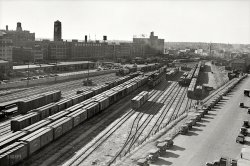
- Muskogee Yards: 1939
- July 1939. "Railroad yards. Muskogee, Oklahoma." Medium format acetate negative by Russell ... we see a baggage car from the Missouri–Kansas–Texas Railroad, nicknamed "The Katy" for its initials, MKT.
Known to legions of ... this be … … the cleanest, best-groomed railroad yard ever to grace the pages of Shorpy?
(The Gallery, Railroads, Russell ... Posted by Dave - 06/17/2021 - 11:18am -
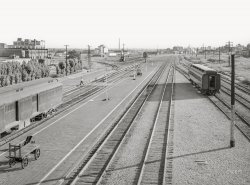
- Erie 2601
- ... out that compounding didn't work as well as expected on railroad locomotives, and later articulated locomotives were built as "simple" ... spent its whole life pushing long trains up the hump of a yard where they would be gravity sorted. The idea behind the placement of the ... Posted by Lost World - 09/22/2011 - 11:39pm -
![Erie 2601 Erie 0-8-8-0 Camelback locomotive at Port Jervis, N.Y., in 1911. The camelback design was unique in that the engineer sat in the tiny cab alongside the boiler, while the fireman worked at the usual spot behind the boiler. One of the main disadvantages was the obvious communication problem between engineer and the rest of the train crew while the engine was in operation. The Erie camelback mallets didn't last long, but smaller camelback locomotives survived well into the 1950's on roads like the Jersey Central. View full size.
Photo's History?What might you know of the photo's history? Interesting shot of a very rare locomotive.
Don Hall
Yreka, CA
Erie 0-8-8-0 CamelbackAt Port Jervis, N.Y., in 1911.I model trains in HO scale. I have never seen anything like this engine. I have seen 0-4-0, 0-6-0 and 0-8-0 camel engines, but never an articulated camel. I have a 2-6-6-2 articulated and have seen the 4-8-8-4 UP engines, but not this one. Anyone know where I could get more pictures of this engine?
Don Rowland - donhotrains@cinci.rr.com
[You could try contacting the person who posted this picture. First sign up for a user account, log in, click on his username, and then "contact." - Dave]
Erie 0-8-8-0 malletThe "Mother Hubbards," sometimes called "camelbacks", common on railroads in the Anthricite (hard coal) region of Pennsylvania. IIRC there weren't many articulated locomotives built this way. I believe this particular type of locomotive was typically used in "helper service," pushing coal trains over the mountains.
The design comes from the need for a very large firebox on locomotives burning hard coal. Hard coal required a fairly thin fire to burn well, thus a large area was required to burn the amount of fuel required to generate enough steam. The fact that they burned the lowest quality of coal available didn't help!
This particular locomotive is interesting in that it is a true compound; notice the size of the front low pressure cylinders compared to the high pressure cylinders on the rear engine. This makes it a "true" Mallet.
It turned out that compounding didn't work as well as expected on railroad locomotives, and later articulated locomotives were built as "simple" engines.
I've never seen any of the larger Mother Hubbards in service, but I did see several of the smaller 0-6-0s and 0-4-0s in active service.
BTW & FWIW - in the 70's we lived in McCloud for four years. Beautiful country in that end of the state!
Erie 0-8-8-0- More photos (Link)There are a few more photos of these engines at:
http://www.rr-fallenflags.org/el/loco/erie-lmn.html
Erie Engine No. 2601 Derailed at Gulf SummitIn my wife's hometown paper (The Deposit Courier), the "Looking Back" section "100 Years Ago, 12 October 1910" says, "Erie engine No. 2,601, one of the largest engines in the world, was derailed at Gulf Summit Sunday night. It was pulling a train of about eighty cars and was running along at a fairly good rate of speed when suddenly it left the track. The big engine pounded along the rails for about 500 yards, cutting off the ends of the ties and tearing up the roadbed for a considerable distance. The Susquehanna wrecking crew was called and repaired the damage."
Only oneThere was only one of this type of locomotive ever built, and it was used for only one thing. Hump work. Basically this engine spent its whole life pushing long trains up the hump of a yard where they would be gravity sorted. The idea behind the placement of the cab was more for visibility than anything. As for communication, the engineer and fireman used their own whistles to communicate between themselves. The engineer used the train whistle, the fireman had a lighter, lower whistle he used.
There were three of theseThere were three of these used for pusher service, not hump service. Only the ERIE had articulated camelbacks, no other road had them. They were all rebuilt later with their cabs at the back.
There were alot of camelbacks in the east and even some western roads had them: Santa Fe, Canadian Pacific, MKT, Chicago & Indiana Coalm, C&IE, to name a few.
There are more pictures all over the Internet, even a color painting.
An HO scale model just sold on Ebay for over $3000.00!
(ShorpyBlog, Member Gallery, Railroads)](https://www.shorpy.com/files/images/erie.thumbnail.jpg)
- Pere Marquette: 1910
- ... second Pere Marquette 18 was launched at the South Chicago yard of the American Ship Building Company on December 20, 1910, and entered ... in the picture - perhaps a spring or summer excursion for railroad employees? There's even a bass drum on board, right above the 'P' in ... Posted by Dave - 07/20/2012 - 3:42pm -
![Pere Marquette: 1910 The Chicago River circa 1910. "Pere Marquette transfer boat 18 passing State Street bridge." Railcar ferry built in a record 90 days after its namesake sank in Lake Michigan. Detroit Publishing Company glass negative. View full size.
Father MarquetteThe first Pere Marquette 18 was built 1902 at Cleveland by the American Ship Building Company. During the summers of 1909 and 1910 the Pere Marquette Railway chartered this vessel to a group from Grand Haven, Michigan, known as the Chicago Navigation Company and who placed her in the excursion trade between Chicago and Waukegan. A rail ferry that ran across Lake Michigan from Ludington, Michigan, to points in Wisconsin, her car deck was used as a dance floor and rumored to also house gambling operations. Returning to Ludington after Labor Day, she re-entered service September 8, 1910, sailing late that night to Milwaukee with twenty-nine rail cars aboard. At 3 AM she began taking on water which the pumps could not handle. At around 4 PM her captain sent out a CQD (forerunner of the SOS) distress message by wireless, attracting the vessel's near-sister, the Pere Marquette 17, which attempted to maneuver close enough to the stricken Pere Marquette 18 to remove passengers and crew. Suddenly, a little after 7 AM, her stern plunged beneath the water and she went straight down in a matter of seconds, it estimated twenty-seven to twenty-nine lives lost.
The Pere Marquette ordered a replacement immediately. Incredibly, the second Pere Marquette 18 was launched at the South Chicago yard of the American Ship Building Company on December 20, 1910, and entered service the next month. Removed from service 1954, as a little kid I recall her sitting forlornly on Pere Marquette Lake at Ludington until she was towed to Hamilton, Ontario, in 1957 for scrapping.
The tug T. T. Morford shown was built 1884 by the Miller Brothers at Chicago, and her design proved so successful that she became the model upon which almost every subsequent Chicago harbor tug would be built.
PM18 (II)Launched December 20, 1910, in Chicago. More here.
T T MorfordThe TT Morford was a tugboat with an interesting history:
The tugboat T.T. MORFORD was built in 1884 at Chicago and served the area faithfully until 26 October 1895, when her boiler exploded. She was rebuilt and went back into service adding another strange twist to history, for it was this same tugboat that 14 years later would rescue 20 or more people from Chicago's 68th Street Water Crib Fire. A fire which killed 60 men in January of 1909.
The vessel shownis the first Pere Marquette 18 while chartered to the Chicago Navigation Company, taking summer excursionists to Waukegan, to clarify my earlier post. The second Pere Marquette 18 remained exclusively in the rail trade between Ludington and Wisconsin ports its entire career.
[Why do we think this is the first Pere Marquette? - Dave]
An Excursion?Seems to be a significant number of the fairer sex aboard, and the ship seems to be riding very high in the water, so I don't think it has a load on. The ship was launched December 20, and arrived in Ludington Michigan on January 30 - it sure doesn't look like mid winter in the picture - perhaps a spring or summer excursion for railroad employees? There's even a bass drum on board, right above the 'P' in the ship's name.
[Midwinter would be February. December 20 is (barely) fall. But yes, it was chilly -- the high was 32, so this is probably not launch day. It may not even be launch year. - Dave]
The control houseseems to match that of the first PM 18:
http://www.carferries.com/pm/PM18/
vs PM 18 (II):
http://www.carferries.com/pm/PM182/
(The Gallery, Boats & Bridges, Chicago, DPC)](https://www.shorpy.com/files/images/4a18153a.thumbnail.jpg)
- A.S. Gerdee: 1943
- ... 3251 Maypole Street, Chicago, a switchman at the Proviso Yard of the Chicago & North Western Railroad. View full size. 4x5 Kodachrome transparency by Jack Delano, ... Posted by Dave - 08/30/2012 - 9:22pm -
![A.S. Gerdee: 1943 April 1943. A.S. Gerdee of 3251 Maypole Street, Chicago, a switchman at the Proviso Yard of the Chicago & North Western Railroad. View full size. 4x5 Kodachrome transparency by Jack Delano, Office of War Information.
KodachromeI love these 4x5 Kodachromes. For the life of me I can't figure out why anyone would shoot anything else (alright, I do really know why but it's still cool stuff). Its such a shame it's not made anymore.
KodachromeI remember shooting a couple of rolls of Kodachrome 25 about 20 or 25 years ago. Absolutely gorgeous results, no perceptible grain, just beautiful. At that time the only people who developed it was Kodak, so you had to send it off in a mailer and in time you'd get your little box of slides back.
KodachromeWell, it is still being made, but only as 64 ISO (ASA) 35 mm film. There are only a few labs left in the world that can process Kodachrome. Also the colour rendition of modern Kodachrome is a bit different from the "classic" emulsion that you see so much of on these pages.
I do hope that Dave will keep on posting Kodachrome images by Jack Delano, he is my favourite.
[As long as Jack keeps taking them, I'll keep posting them! - Dave]
KodachromeThey give us those nice bright colors
They give us the greens of summers
Makes you think all the worlds a sunny day, oh yeah
ImmortalMr. A. S. Gerdee, you have been immortalized, my friend!
C. W. MossNow we know where the mechanic from Bonnie & Clyde ended up.
(The Gallery, Kodachromes, Chicago, Jack Delano, Portraits, Railroads)](https://www.shorpy.com/files/images/1a34669u.thumbnail.jpg)
- A Pretty Grille: 1941
- ... Chevys or (fill in dream car here) was found, lost by the railroad for decades, on a siding in Michigan or Ohio or Canada. Ah, well. ... stumbled across three of these cars abandoned in an old yard. Took some working to figure out, but the cars had apparently been lost in ... Posted by Dave - 12/29/2014 - 2:28pm -
![A Pretty Grille: 1941 San Francisco, 1941. "Pontiacs being unloaded from freight cars." Slathered with chrome. 8x10 Eastman Kodak Safety Film negative. View full size.
Last of the New Cars for ConsumersI'm supposing that these are being unloaded not long before the attack on Pearl Harbor.
These represent the last model year of new cars available to consumers until World War 2 was finished. Sales of new automobiles were severely limited for the duration.
[You're a year off. These are 1941 Pontiacs; 1942 was the last model year for new cars before the war. - Dave]
Note that the Pontiacs are being unloaded from special end-door RR boxcars. The boxcars shown have now-obsolete features such as full-height ladders and roof walks. Examining the boxcar doors close up will reveal minor damage.
Autos are still shipped extensively by rail, but the current auto carriers have three decks!
Put them back in the freight carThen wait 75 years and open it again.
What a time capsule that would be!
Illuminating?I refer to the hood ornament which looks like clear plastic and just might have lit up at night.
Barn FindReminds me of an urban legend current when I was young in Minnesota circa 1980. A boxcar (or two, or three) filled with 1949 Hudsons or '42 Chevys or (fill in dream car here) was found, lost by the railroad for decades, on a siding in Michigan or Ohio or Canada. Ah, well. Great photo.
Chief Pontiac's faceDid not light up until 1949.
Bryant StreetBuilding in background is the Hamm's Brewery at 1550 Bryant Street. See this photo across railroad loading docks. My guess is that the photo was taken at the former site of the Southern Pacific 16th Street freight depot, located around Treat Street between Florida and Harrison. The Shorpy photo and the one below both appear to be from around Treat Street. looking towards Florida. A 1960s track diagram for the Southern Pacific doesn't indicate a match for the freight sheds and ramp for unloading (see Zone 8 page 1). The track diagram does indicate track 828 was the "old 16th Street Freight Depot," suggesting the tracks had been rearranged before 1960.
Interesting story here.The type of railroad car is an "end door" type. They were designed for carrying automobiles, or larger loads. The end doors were only on one end though, meaning that to unload, you had to move the cars around after each was emptied. Bout twenty years ago, in a small town in Georgia, they stumbled across three of these cars abandoned in an old yard. Took some working to figure out, but the cars had apparently been lost in transit to a local dealership in Savannah. Sidelined due to something wrong with the trucks (bogies the cars ride on.) The cars were just forgotten. Well, when the crews found them, they asked what to do and were told to just scrap them. Opening the doors, they found that each car held three brand new Ford Galaxies, with all of six miles on the odomoter. The owner of the company doing the demolition took two for himself, and divided the remaining cars among his crew. One of the cars sold at Barret's auto auction some years back, with the winning bid being over one million dollars.
(The Gallery, Cars, Trucks, Buses, Railroads, San Francisco)](https://www.shorpy.com/files/images/SHORPY-171-01.thumbnail.jpg)
- Willow Springs: 1900
- ... your own risk these days One source reports that when railroad service was established between Willow Springs and Chicago, city folk ... many of which are shuttled to the adjacent BNSF intermodal yard (another very large facility).
I assume the fellow in the image is ... Posted by Dave - 11/13/2012 - 1:13pm -
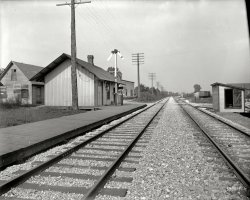
- This & That: 1907
- ... is a southeasterly direction along Elm Street, toward the railroad tracks and Union Avenue. Park Street is on the left in the foreground. ... and axle sets, next to the rail crossing. Maintenance yard, perhaps?
[It's the depot seen in the other view. - Dave]
IOOF ... Posted by Dave - 04/29/2013 - 9:46am -
![This & That: 1907 Circa 1907. "Street in Lakeport, New Hampshire." Points of interest in this view of the fair city (last seen here) include the Lovejoy & Prescott fire insurance agency, Adkin & Adkin Millinery, the L.E. Pickering restaurant, Frank Clow Wood & Coal ("Hard, Soft, Bobbin & Slab"), W.A. Moore Boots & Shoes, and a lady having a conversation with her horse. Not pictured: sign painter with a graduate degree in ampersands. 8x10 glass negative, Detroit Publishing. View full size.
Building at the far endThree story building beyond the tracks is still there, corner of Clinton & Union.
Engine House louvers?The wheelsets and the large louvered clerestory that you can see along the tracks behind the white building makes me think the building with the clerestory was an engine house. It would be typical to find wheelsets there, supporting minor car repairs and the occasional wreck.
Still aroundThe squarish building in the background with the narrow windows is still around today, on the corner of Union Avenue and Elm Street. Its exterior is still recognizable though no longer so ornate.
The photo is looking is a southeasterly direction along Elm Street, toward the railroad tracks and Union Avenue. Park Street is on the left in the foreground.
Asphalt sidwalks?What caught my eye in this scene is the smooth seamless surface of the sidewalks. Could that be asphalt in 1907?
Nice looking town. I could live here. Should be able to get a job as a street cleaner at least.
Aerial PollutionI recently moved from a neighborhood with underground utilities to one with poles and overhead service cables as shown here, and it's taken a while to get used to the older aesthetic. Nonetheless, when this photo was taken, overhead electrical "plumbing" denoted progress, modernity, and all the other Babbitt-esque values. And, if you had a service cable running in plain sight from the street into your home and your neighbor did not, an added increment of socioeconomic status accrued to you as well.
Behind the collieryA field full of wheel and axle sets, next to the rail crossing. Maintenance yard, perhaps?
[It's the depot seen in the other view. - Dave]
IOOF GARIndependent Order of Odd Fellows
&
Grand Army of the Republic
I made sure to use an ampersand, in keeping with the local zoning code.
Square utility poles?Square utility poles. I can't say I've even seen that before.
New HampshireThe "Granite State;" lots of granite in evidence here.
(The Gallery, DPC, Small Towns)](https://www.shorpy.com/files/images/SHORPY_4a18358a.thumbnail.jpg)
- Houses on the Hill: 1935
- ... There was a James Garner TV-movie (he worked for a railroad) where each time he went across his back yard headed for the outhouse, the annoying little neighbor girl would say, "I ... Posted by Dave - 09/09/2011 - 12:22pm -
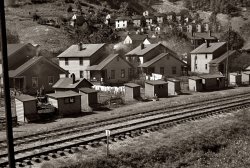
- Milwaukee Yards: 1941
- June 1941. "Railroad yards. Milwaukee, Wisconsin." Medium format acetate negative by John ... The tracks under the bridge would become the Hump Yard in about 1949, with 24 classification tracks taking a steady stream of ... cars 24/7. The tracks to the left constituted the Airline Yard. The large building in the upper left corner is the old Johnson Cookie ... Posted by Dave - 03/22/2020 - 12:44pm -
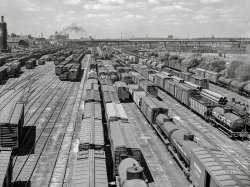
- Work, Read, Wash: 1943
- March 1943. Barstow, California. "Railroad worker in the washroom of the reading room in the Santa Fe yard." Medium-format negative by Jack Delano for the Office of War Information. ... Posted by Dave - 07/29/2016 - 8:13pm -
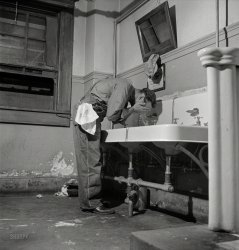
- Emporia Junction: 1943
- ... the Atchison, Topeka & Santa Fe train pulls into the yard." Medium-format negative by Jack Delano for the Office of War Information. ... and levers, called piping, to control the position of a railroad switch or signal up to half a mile away. This piping can be seen ... Posted by Dave - 12/06/2014 - 1:28pm -
